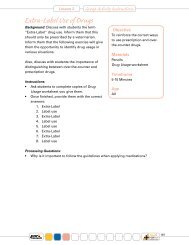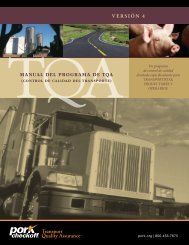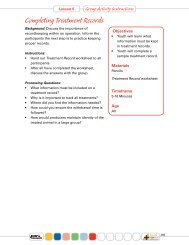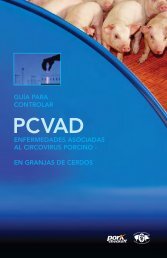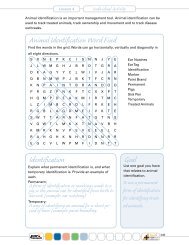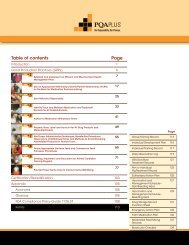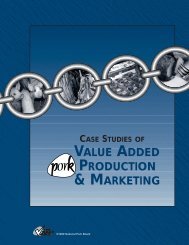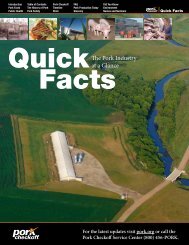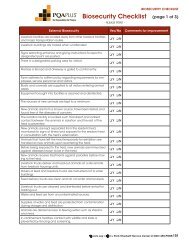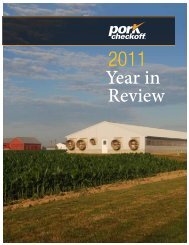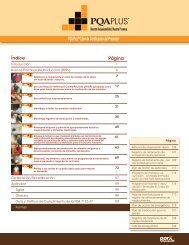PRRS Compendium Producer Edition - National Pork Board
PRRS Compendium Producer Edition - National Pork Board
PRRS Compendium Producer Edition - National Pork Board
Create successful ePaper yourself
Turn your PDF publications into a flip-book with our unique Google optimized e-Paper software.
secretions). The aggressive behavior associated with establishing a social order within a group that<br />
involves slashes or bites in the shoulders, neck, and head and results in the exchange of blood and<br />
saliva and transmission of <strong>PRRS</strong> virus. Indirect transmission by fomites, vectors, or aerosols may also<br />
occur. Of these, transmission via instruments and medications contaminated with body fluids from<br />
<strong>PRRS</strong> virus-infected animals is the most important. This includes instruments used for ear notching, tail<br />
docking, teeth clipping, or tattooing, as well as and needles, syringes, medications, and biologics. Recent<br />
research has shown that flies and mosquitoes are capable of mechanical transmission of <strong>PRRS</strong> virus<br />
under experimental conditions (Otake et al., 2002c, 2002d). Establishing whether <strong>PRRS</strong> virus is an insectborne<br />
disease will require additional experimental and field studies. Aerosol transmission is also still an<br />
open question. Results of pig-to-pig aerosol transmission experiments have been mixed and essential<br />
information (the quantity of virus excreted by pigs and the rate of inactivation of aerosolized virus) is<br />
missing.<br />
The ability of <strong>PRRS</strong> virus to establish persistent infections in animals is the primary challenge to successful<br />
prevention and control programs. Establishing and maintaining herd immunity in the face of persistent<br />
infection is problematic because vaccines that induce long-term protective immunity against heterologous<br />
isolates and eliminate or reduce virus shedding are not yet available. Finally, if elimination is achieved,<br />
herds are vulnerable to re-infection with <strong>PRRS</strong> virus through the introduction of subclinically-infected<br />
animals or by area spread. This scenario is reminiscent of other infectious agents, i.e., classical swine<br />
fever virus (hog cholera) or African swine fever, which have been successfully controlled and/or eliminated<br />
in the past through coordinated regional efforts.<br />
References<br />
Albina E, Madec F, Cariolet R, Torrison J. 1994. Immune response and persistence of the porcine reproductive and respiratory syndrome virus in<br />
infected pigs and farm units. Vet Rec 134:567-573.<br />
Anon. 1991. The new pig disease: Conclusions reached at the seminar. In: The new pig disease. Porcine reproductive and respiratory syndrome. A<br />
report on the seminar/workshop held in Brussels on 29-30 April 1991 and organized by the European Commission Directorate General for Agriculture,<br />
pp. 82-86.<br />
Benfield DA, Christopher-Hennings J, Nelson EA, et al. 1997. Persistent fetal infection of porcine reproductive and respiratory syndrome (<strong>PRRS</strong>) virus.<br />
Proceedings of the American Association of Swine Veterinarians, pp. 455-458.<br />
Benson JE, Yaeger MJ, Lager KM. 2000. Effect of porcine reproductive and respiratory syndrome virus (<strong>PRRS</strong>V) exposure dose on fetal infection in<br />
vaccinated and nonvaccinated swine. Swine Health and Production 8(4):155-160.<br />
Bierk MD, Dee SA, Rossow KD, et al. 2001. Transmission of porcine reproductive and respiratory syndrome virus from persistently infected sows to<br />
contact controls. Can J Vet Res 65:261-266.<br />
Bloemraad M, de Kluijver EP, Petersen A, et al. 1994. Porcine reproductive and respiratory syndrome: temperature and pH stability of Lelystad virus and<br />
its survival in tissue specimens from viraemic pigs. Vet Microbiol 42:361-371.<br />
Christianson WT, Choi CS, Collins JE, et al. 1993. Pathogenesis of porcine reproductive and respiratory syndrome virus infection in mid-gestation sows<br />
and fetuses. Can J Vet Res 57:262-268.<br />
Christianson WT, Collins JE, Benfield DA, et al. 1992. Experimental reproduction of swine infertility and respiratory syndrome in pregnant sows. Am J<br />
Vet Res 53:485-488.<br />
Dee S, Deen J, Rossow K, et al. 2002a. Mechanical transmission of porcine reproductive and respiratory syndrome virus throughout a coordinated<br />
sequence of events during cold weather. Can J Vet Res 66:232-239.<br />
Dee S, Deen J, Rossow K, et al. 2002b. Mechanical transmission of porcine reproductive and respiratory syndrome virus throughout a coordinated<br />
sequence of events during warm weather. Can J Vet Res (in press).<br />
Dee SA, Joo HS, Henry S, et al. 1996. Detecting subpopulations after <strong>PRRS</strong> virus infection in large breeding herds using multiple serologic tests. Swine<br />
Health and Production 4(4):181-184.<br />
Dee SA, Joo HS. 1994. Prevention of the spread of porcine reproductive and respiratory syndrome virus in endemically infected pig herds by nursery<br />
depopulation. Vet Rec 135:6-9.<br />
Dee SA. 1992. Investigation of a nationwide outbreak of SIRS using a telephone survey. American Association of Swine Practitioners Newsletter 4:41-<br />
44.<br />
Dewey C, Charbonneau G, Carman S, et al. 2000. Lelystad-like strain of porcine reproductive and respiratory syndrome virus (<strong>PRRS</strong>V) identified in<br />
Canadian swine. Can Vet J 41:493-494.<br />
Freese WR, Joo HS, Simonson RR. 1993. A potential spontaneous elimination of porcine endemic abortion respiratory syndrome (PEARS) virus spread<br />
in a commercial swine herd. Proceedings of the International Pig Veterinary Society Congress, p. 66.<br />
Goldberg TL, Hahn EC, Weigel RM, Scherba G. 2000. Genetic, geographical and temporal variation of porcine reproductive and respiratory syndrome<br />
PAGE<br />
PIG 04-01-09





